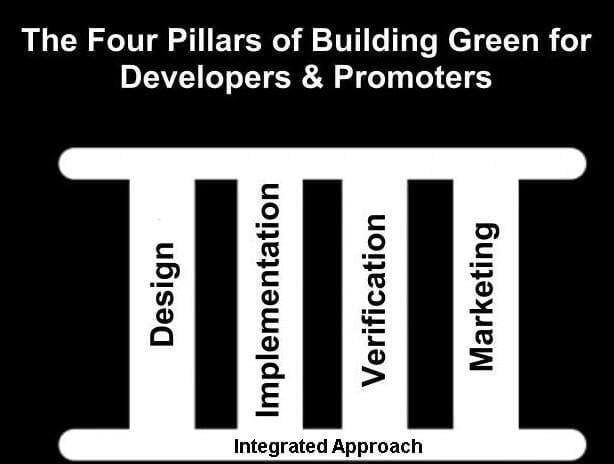A common grouse among many property developers is that unless the buyers are willing to pay a premium on green developments, building green would be a pointless exercise because all the benefits of the green building are only enjoyed by the occupants and in many cases they may not even realise they are occupying a space that is more efficient than many of the other developments around. In such cases there is absolutely no value creation for the developer in spite of all the additional effort and in some cases, additional expenditure put in to the project. This is where the role of green marketing becomes very important. Green marketing according to me is one of the four pillars of building green, other three being design, implementation and verification & action. All these four pillars are interdependent and a green building project can add value only if all the four pillars are equally strong.

Studies have shown that green building space commands a premium of at least 6% in some countries. In the Indian scenario there is no evidence of buyers willing to pay a premium for such a space but this is only because real estate developers have still not figured how to communicate the value of certified green developments to potential buyers who are completely unaware of the concept. In the case of buildings, green marketing essentially means informing the buyers the environmental and economic value of the green building project in question. This becomes easier in case of certified green developments because there is always a third party verified documentary evidence proving the information on performance of the building. In all our projects we have started to provide marketing assistance to our clients through the following measures:
Once a client brings us in to help them design, build and certify their projects, we start off by creating a draft strategy document. This strategy document contains a summary of recommendations on how the project can achieve each criteria with minimum effort and maximum return on investment.
After a few rounds of discussing the strategies with the client and all other stakeholders involved and also doing some performance analysis of our own we get a final project narrative which in principal has been agreed up on by all parties that matter.
Using information in the narrative document we create a owner's manual or home buyer's guide. This guide contains the following information:
- An introduction to the green home
- Warranty information
- Green Building certification achieved
- How the project achieved (or intends to achieve) the green building certification. This information is listed under various performance areas like energy, water etc. It is always concise and easy to understand.
- A list of maintenance dos and don't to keep to building performing as per design standards. This may include green cleaning options.
- How to lead and environmentally conscious lifestyle.
- How to manage waste and water
- List of all the paints and chemicals used in the project
- Important locations like water shut off valve, fuse box, gas shut off valve etc.
- Emergency contacts
- How to save on energy and water along with renewable energy options buyers could consider
The list can be as comprehensive as one likes but the information has to be easy to understand and act up on.
This guideline is sent to the marketing department for beautification and distribution among all potential buyers. This gives the buyer an understanding of how the green building is superior and sense of confidence towards the developer. This information when discussed in person without the inclination to make a sale at any cost, always works wonders, if not a sale it at least generates awareness on building performance and the value the developer is trying to create.
Such information is usually ignored in the glossy brochures highlighting all the amenities that only end up costing the buyer more money in maintenance and repair. Maybe for a change if developers started to highlight performance features that save buyers money and make them less reliant on external services, people will be more inclined to pay a premium to buy into green developments.

